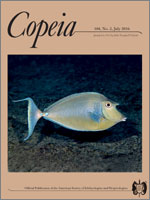Urban development is known to alter the structure, chemistry, and biota associated with stream systems; however, little is known about the dynamics of anurans that breed in and around streams. We used automated devices to record breeding anurans for one year across a forested gradient in an effort to identify species-specific sensitivities to urbanization. Six of 13 total species found during the study were present in surveyed streams that were representative of a gradient ranging from heavily urbanized to largely forested, and maximum species richness occurred in watersheds with rapid urban development but low values of impervious surfaces such as pavement and roof tops. The best landscape-scale predictor of assemblage metrics such as species richness, total species activity, and species diversity was generally percent forest cover at the watershed scale (or in very large buffers around the sample point). We used Bayesian inference to estimate detection probability and occupancy for 11 species. While detection probability varied across sampling occasions, there was no evidence that occupancy was a function of forest loss for any species. Urban streams and riparian areas are often severely altered when compared to similar habitats in forested areas. Anuran richness and diversity from urban areas was not altered to the same extent as caudates, which have been sampled from these same streams in previous studies. Increased vagility of anurans, coupled with different breeding strategies, may help to explain this discrepancy.
BioOne.org will be down briefly for maintenance on 17 December 2024 between 18:00-22:00 Pacific Time US. We apologize for any inconvenience.
How to translate text using browser tools
28 June 2016
Stream and Riparian Habitat Use by Anurans along a Forested Gradient in Western Georgia, USA
Kyle Barrett,
Craig Guyer,
Stephen T. Samoray,
Yoichiro Kanno
ACCESS THE FULL ARTICLE





